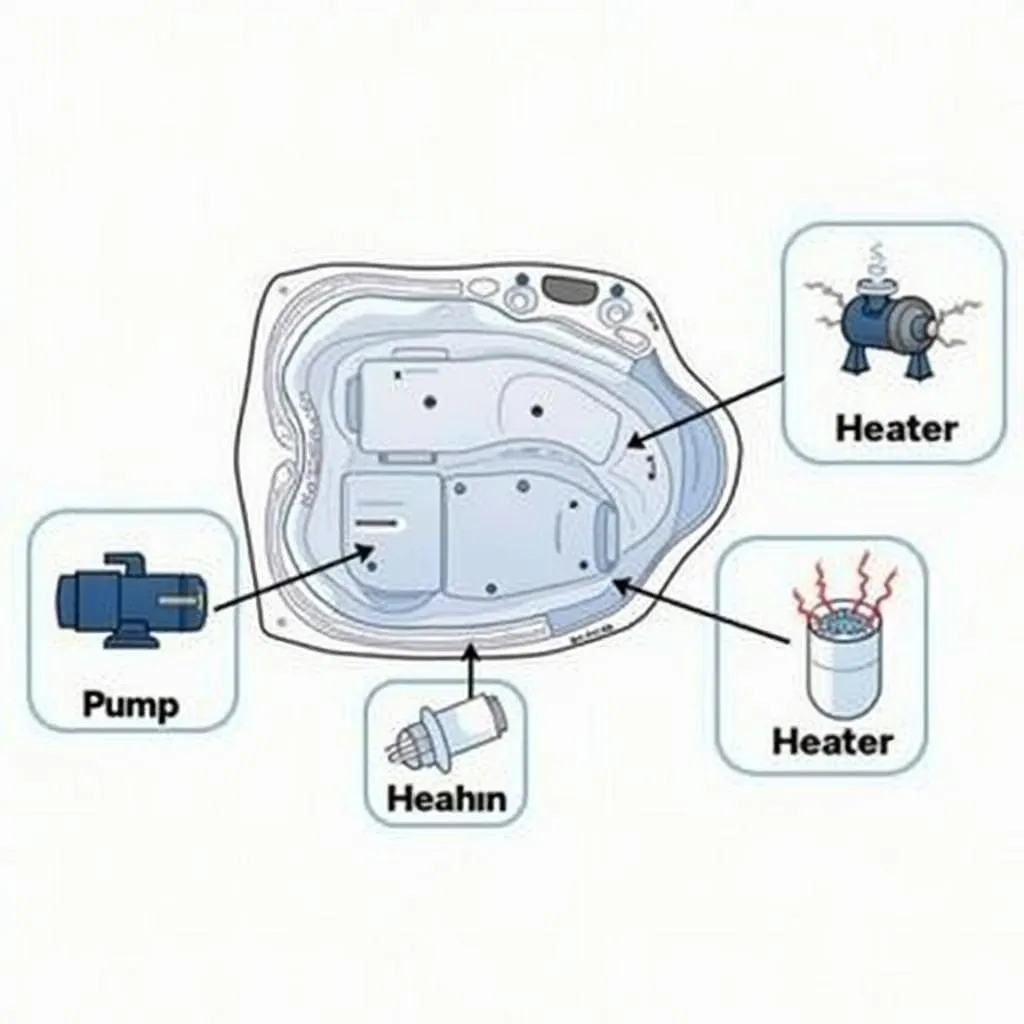Investing in a home spa is an investment in your well-being. Whether you’re looking to unwind after a long day or soothe aching muscles, a spa offers a sanctuary of relaxation right in your backyard. But before you take the plunge, understanding the essential equipment, particularly spa pumps, is crucial. This comprehensive guide delves into the world of spa pumps and explores the key components that ensure your spa runs smoothly and efficiently.
The Heart of Your Spa: Understanding Spa Pumps
At the core of every spa lies its pump, the driving force that circulates water, powers jets, and ensures optimal performance. Spa pumps are responsible for:
- Water Circulation: Spa pumps create a continuous flow of water, preventing stagnation and maintaining a consistent temperature throughout.
- Jet Operation: The invigorating hydrotherapy jets that provide a therapeutic massage rely on the powerful pressure generated by the spa pump.
- Filtration: By circulating water through the filter system, spa pumps remove impurities and debris, keeping the water clean and crystal clear.
Types of Spa Pumps: Choosing the Right Fit
Selecting the right spa pump depends on factors like the size of your spa, the number of jets, and your desired water pressure. Here are the two main types of spa pumps to consider:
- Single-Speed Pumps: As the name suggests, these pumps operate at a single, constant speed. They are suitable for smaller spas with fewer jets and offer a more budget-friendly option.
- Two-Speed Pumps: Offering greater versatility, two-speed pumps can operate at both high and low speeds. The high speed powers the jets, while the low speed is ideal for circulation and filtration, ensuring energy efficiency.
 Types of Spa Pumps
Types of Spa Pumps
Factors to Consider When Choosing Spa Pumps
- Horsepower (HP): A higher horsepower rating indicates a more powerful pump, capable of delivering stronger jet pressure. Consider the number and size of jets in your spa when choosing the appropriate horsepower.
- Flow Rate: Measured in gallons per minute (GPM), flow rate determines how quickly the pump can circulate water. A higher flow rate ensures efficient filtration and heating.
- Noise Level: Opt for pumps with lower decibel ratings to enjoy a more tranquil spa experience. Look for pumps that utilize noise-reduction technology.
- Energy Efficiency: Choosing an energy-efficient pump can lead to significant savings on your electricity bill in the long run.
Beyond Spa Pumps: Essential Spa Equipment
While spa pumps are essential, several other components work in harmony to create the ultimate spa experience:
- Heaters: Spa heaters maintain the perfect water temperature, allowing you to enjoy your spa year-round.
- Filters: Spa filters remove dirt, debris, and impurities from the water, ensuring a clean and hygienic soaking environment.
- Control Systems: Modern spa control systems allow you to adjust settings like temperature, jet pressure, and lighting with ease.
 Essential Components of a Spa System
Essential Components of a Spa System
Maintaining Your Spa Equipment
Proper maintenance is key to extending the lifespan of your spa equipment and ensuring optimal performance.
- Regular Cleaning: Clean your spa filter regularly, and remove any debris from the spa’s surface.
- Water Chemistry: Maintain proper water chemistry by regularly testing and adjusting pH and sanitizer levels.
- Professional Servicing: Schedule annual professional servicing to inspect and maintain your spa equipment, including the pumps, heater, and control system.
Pool and Spa Equipment: Your One-Stop Shop
Finding the right spa equipment, including high-quality spa pumps for sale, doesn’t have to be overwhelming. Reputable suppliers offer a wide range of options to meet your specific needs. “Our commitment to quality and customer satisfaction is unwavering,” says John Smith, Head of Spa Equipment at Korean Spa. “We guide our clients through every step, ensuring they make informed decisions and enjoy a seamless spa experience.”
Investing in Relaxation and Well-being
Investing in a home spa is an investment in your physical and mental well-being. By understanding the essential equipment, particularly spa pumps, you can create a haven of relaxation and rejuvenation right in your backyard. Remember to choose high-quality equipment, prioritize maintenance, and enjoy the countless benefits a well-maintained spa provides.
FAQs About Spa Pumps and Equipment
Q: How long do spa pumps typically last?
A: With proper care and maintenance, spa pumps can last anywhere from 5 to 10 years.
Q: What is the ideal water temperature for a spa?
A: Most people find a water temperature between 100°F (38°C) and 104°F (40°C) to be comfortable for soaking.
Q: How often should I clean my spa filter?
A: It’s recommended to clean your spa filter every 1-3 months, depending on usage.
Q: Can I replace my spa pump myself?
A: While it’s possible to replace a spa pump yourself, it’s often best to consult with a professional for proper installation.
Q: How much does it cost to run a spa?
A: The running costs of a spa vary depending on factors like spa size, usage, and energy efficiency of the equipment.
For more information on spa pumps and equipment, explore our website or contact our team of experts. We’re here to help you create the perfect spa oasis for ultimate relaxation and well-being.